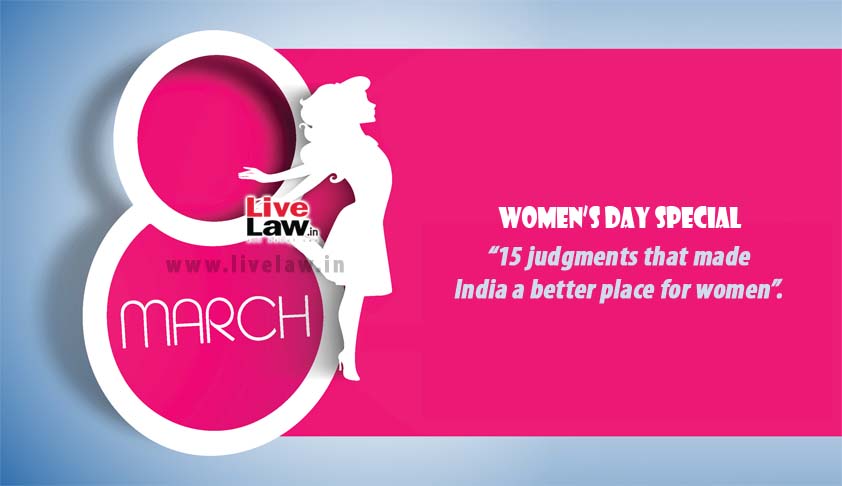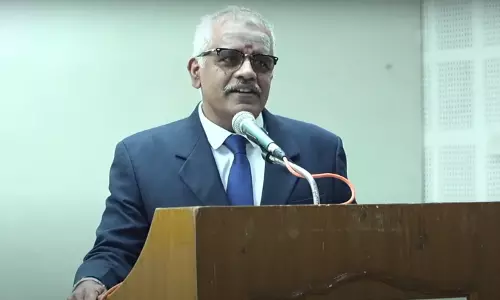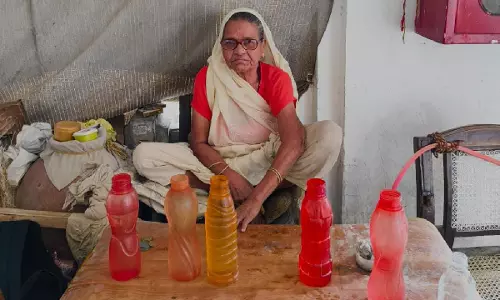Women’s Day Special: 15 Supreme Court judgments that made India a better place for women

“Women have served all these centuries as looking glasses possessing the magic and delicious power of reflecting the figure of man at twice its natural size.” -Virginia Woolf, A Room of One's OwnWomen have always been considered as the weaker sections of the society, as the victims. They have been shown merely as characters in a man’s world. What they don’t realise is that women...
“Women have served all these centuries as looking glasses possessing the magic and delicious power of reflecting the figure of man at twice its natural size.” -Virginia Woolf, A Room of One's Own
Women have always been considered as the weaker sections of the society, as the victims. They have been shown merely as characters in a man’s world. What they don’t realise is that women are leaders everywhere you look, from the CEO who runs a Fortune 500 company to the housewife who raises her children and heads her household. Whatever glory belongs to the race for a development unprecedented in history for the given length of time, a full share belongs to the womanhood of the race (Mary Jane McLeod Bethune).
These judgments reflect the women’s strength. Each of these judgments should be viewed as the tryst of a woman to reassert her strength, to redefine the patriarchal laws. They show how a woman succeeded in being the voice of thousands of other women, how they stepped up as women and took the lead.
“Above all, be the heroine of your life, not the victim.” ― Nora Ephron
1. Vishaka & Ors. V. State of Rajasthan & Ors., (1997) 6 SCC 241
As Zia Mody says in her book, Ten Judgements that Changed India, "Judicial activism reached its pinnacle in Vishakha Vs. State of Rajasthan."
The Bench, comprising of Chief Justice Verma, Justice Sujatha Manohar and Justice B.N. Kirpal issued Guidelines to prevent sexual harassment against women in work places. All complaints of sexual harassment by any woman employee would be directed to this committee. This is significant because an immediate supervisor may also be the perpetrator. The committee advises the victim on further course of action and recommends to the management the course of action against the man accused of harassment. This verdict was superseded by the Sexual Harassment of Women at Workplace (Prevention, Prohibition and Redressal) Act, 2013.
2. Vaddeboyina Tulasamma v. Vaddeboyina Shesha Reddi, 1977 SCR (3) 261
The Supreme Court in this case highlighted the Hindu female’s right to maintenance as a tangible right against property which flows from the spiritual relationship between the husband and wife. The Bench comprising of Justice P.N. Bhagwati, Justice A.C. Gupta and Justice S.M. Fazal Ali held that Section 14(1) of the Hindu Succession Act, 1956 must be liberally construed in favour of the females so as to advance the object of the Act. This section makes female Hindu a full owner of a property, instead of a limited owner.
3. Mrs. Mary Roy Etc. v. State Of Kerala & Ors, 1986 AIR SC 1011
The Supreme Court in this case held that Christian women are entitled to have an equal share in their father's property. This path-breaking judgment sent shock waves throughout the country. Till then, Christian women in Kerala were governed by the provisions under the 1916 Travancore-Kochi Christian Succession Act. Under this Act, a Christian daughter can inherit only one fourth of the share of the sons in her father’s property.
The Bench comprising of Chief Justice P.N. Bhagwati and Justice R.S. Pathak gave a liberal interpretation that benefited the Christian women in Kerala and brought them within the ambit of the Indian Succession Act, 1921. Better still, the ruling granted equal rights to Christian women with retrospective effect.
4.Mohd. Ahmed Khan v. Shah Bano Begum, (1985 SCR (3) 844)
The Supreme Court in this case ruled in favour of Shah Bano and ordered maintenance from her ex-husband under Section 125 of the Criminal Procedure Code (with an upper limit of Rs. 500 a month) like any other Indian woman. The judgment was not the first granting a divorced Muslim woman maintenance under Section 125. But a voluble orthodoxy deemed the verdict an attack on Islam. This was a milestone in the Muslim women’s search for justice.
However, the Muslim Women (Protection of Rights on Divorce) Act, 1986 has been seen as making an attempt to dilute the effects of this judgment. The Act was seen as discriminatory as it denied divorced Muslim women the right to basic maintenance which women of other faiths had recourse to under secular law.
5.Shamim Ara v. State of U.P., 2002 (7) SCC 518
The Supreme Court in this case held that the requirements of a valid talaq are:
(i) That the talaq must be for a reasonable cause; and
(ii) It must be preceded by attempts of reconciliation between the husband and the wife by two arbiters - one chosen by the wife from her family and the other by the husband from his family. If their attempts fail, talaq can be affected.
6. Daniel Latifi v. Union of India, 2001 (7) SCC 740
A Constitutional Bench of the Supreme Court in this case held that liability of Muslim husband to his divorced wife arising under Section 3(1) (a) of the Act to pay maintenance is not confined to iddat period. The Bench comprising of Justice G.B. Pattanaik, Justice S. Rajendra Babu, Justice D.P. Mohapatra, Justice D. Raju and Justice Shivraj Patil held that a Muslim husband is liable to make reasonable and fair provision for the future of the divorced wife which obviously includes her maintenance as well. Such a reasonable and fair provision extending beyond the iddat period must be made by the husband within the iddat period in terms of Section 3(1) (a) of the Act.
According to the Court, a divorced Muslim woman who has not remarried and who is not able to maintain herself after iddat period can proceed against her relatives who are liable to maintain her in proportion to the properties which they inherit on her death according to Muslim law from such divorced woman including her children and parents. If any of the relatives being unable to pay maintenance, the Magistrate may direct the State Wakf Board established under the Act to pay such maintenance.
7. Lata Singh v. State of Uttar Pradesh, 2006 (6) SCALE 583
Noting that there was no bar to inter-caste marriage under the Hindu Marriage Act, a Division Bench of the Supreme Court comprising of Justice Ashok Bhan and Justice Markandey Katju observed that since there was no dispute about the petitioner being a major, "she was free to marry anyone she likes or live with anyone she likes".
The court held that no offence had been committed by any of the accused. The judgment directs the administration and police authorities throughout the country to ensure that if any boy or girl who is a major enters into an inter-caste or inter-religious marriage with a woman or man who is a major, the couple are not harassed or subjected to threats and violence. The police should institute criminal proceedings against persons who threaten, harass, commit or instigate acts of violence on people who decide on inter-caste or inter-religious marriages.
8. D. Velusamy v. D. Patchaiammal, (2010) 10 SCC 469
The Supreme Court in this case held that Live-in relationships will also come under Domestic Violence Act 2005 . It is held that ‘not all live in relationships will amount to a relationship in the nature of marriage to get the benefit of the Act of 2005. To get such benefit the conditions mentioned by us above must be satisfied, and this has to be proved by evidence. If a man has a `keep' whom he maintains financially and uses mainly for sexual purpose and/or as a servant it would not, in our opinion, be a relationship in the nature of marriage'
9. Roxann Sharma v. Arun Sharma, Civil Appeal No. 1967 OF 2015
The Supreme Court in this case held that in a in a battle between estranged parents, for the custody of minor child, who has not completed five years of age, shall be allowed to remain with the mother. The Bench comprising of Justice Vikramajit Sen and Justice C. Nagappan held that in such cases child should not treated as a "chattel".
10. Seema v. Ashwani Kumar, AIR 2006 S.C 1158
The Supreme Court in this case directed the State Governments and the Central Government that marriages of all persons who are citizens of India belonging to various religious denominations should be made compulsorily registerable in their respective States where such marriages are solemnized. The Bench, comprising of Justice Arijit Pasayat and Justice S.H. Kapadia also directed that as and when the Central Government enacts a comprehensive statute, the same shall be placed before that Court for scrutiny.
This was followed by the 12th Report of the Committee on Empowerment of Women (2006-2007), titled “Plight of Indian Women deserted by Indian husbands”, the 18th Law Commission of India’s 205th Report titled “Proposal to Amend the Prohibition of Child Marriage Act, 2006 and Other Allied Laws” and 211th Report titled “Laws on Registration of Marriage and Divorce- A proposal for consolidation and Reform”. All these reports recommended compulsory registration of marriages. This prompted the Government to amend the Registration of Births and Deaths Act, 1969 to provide for the regulation of registration of births and deaths and for the matters connected therewith.
11. Dr. Upendra Baxi & Ors. v. State of Uttar Pradesh, AIR 1987 SC 191
The Supreme Court in this case had treated a letter as a Writ Petition. The Petitioners had pointed out that the conditions in which girls were living in the Government Protective Home at Agra were abominable and they were being denied their right to live with basic human dignity by the State of Uttar Pradesh which was running the Protective Home. The Bench, comprising of Justice P.N. Bhagwati, Justice G. Oza and Justice V. Khalid issued several directions to the State Government for better administration of protective homes, such as proper ventilation, mosquito nets and cooking gas provisions. The Superintendent of the Protective Home was directed to take care that no woman or girl is detained in the Protective Home without due authority and process of law. The District Judge, Agra was directed to nominate two socially committed advocates who would by turns visit the Protective Homes once in a fortnight.
12. Sakshi v. Union of India, AIR 2004 SC 3566
A Supreme Court Bench comprising of Chief Justice Rajendra Babu and Justice G.P. Mathur passed directions that must be adhered to while conducting trial of child sexual abuse or rape. They were as follows:
- Special arrangements such as a screen must be made so as to ensure that the victim or witness do not see the body or face of the accused.
- The questions for cross examination must be framed and given to the Presiding Officer of the Court who must then put them to the victim or witness in a language that is clear and not embarrassing.
- Adequate breaks must be given to the victims of child abuse or rape while they give their testimony in court.
The Petitioner NGO had also sought a declaration that all forms of penetration be included within “sexual intercourse” in Section 375 of the Indian Penal Code. The Court however declined to redefine rape.
13. R.D. Upadhyay v. State of Andhra Pradesh, AIR 2006 SC 1946
The Supreme Court in this case considered the issue of development of children who are in jail with their mothers, either as undertrial prisoners or convicts. The Bench comprising of Justice Y.K. Sabharwal, Justice C.K. Thakker and Justice P.K. Balasubramanyan observed that the jail environment was certainly not congenial for development of the children. A study was ordered to be conducted by the National Institute of Criminology and Forensic Sciences where certain suggestions were made for proper care of children of women prisoners. It was further suggested that arrest of women suspects be made only by lady police.
Various reports were filed by the State Governments and Union Territories on the issues raised as a result of the study. In light of these reports, the Court issued detailed guidelines for providing various facilities to women prisoners and their children in the following cases: pregnancy; child birth in prison; female prisoners and their children; food, clothing, medical care and shelter; education and recreation for children of female prisoners; diet; etc. Accordingly, the court ordered Jail Manual and other relevant Rules, Regulations, Instructions to be suitably amended within three months so as to comply with the directions.
14. Centre for enquiry into Health and Allied themes (CEHAT) v. Union of India, 2003 (8) SCC 398
The Supreme Court in this case issued Guidelines to prevent female foeticide. The Bench comprising of Justice M.B. Shah and Justice Ashok Bhan further directed that information should be published by way of advertisements as well as on electronic media. The National Monitoring and Inspection Committee constituted by the Central Government for conducting periodic inspection shall continue to function till the Act is effectively implemented. The reports of this Committee were directed to be placed before the Central Supervisory Board and State Supervisory Board for any further action.
The bench also directed that the quarterly reports by the appropriate authority, which are submitted to the Supervisory Board, should be consolidated and published annually for information of the public at large. The States of Jharkhand, Maharashtra, Tripura, Tamil Nadu and Uttar Pradesh were directed to appoint multi member appropriate authorities, as per the requirement under Section 17(3) (a) of the PNDT Act.
15. Delhi Domestic Working Women’s Forum v. Union of India, 1995 SCC (1) 14
Four domestic servants had filed charges of indecent sexual assault against seven army personnel. The Supreme Court pointed out the defects of the existing system while dealing with rape victims, issuing 8 broad parameters while assisting victims of rape. The Bench comprising of Justice S. Mohan, Justice M.N. Venkatachalliah and Justice S.B. Mujmudar emphasised on the legal representation that needs to be provided at the police station. The Police should be under a duty to inform the victim of her right to representation before any questions were asked of her and that the police report should state that the victim was so informed. The advocate should be appointed by the Court, upon application by the Police. However, in order to ensure efficiency, advocates would be authorised to act at the police station before leave of the court was sought or obtained. The Court also mandated anonymity of the victim, along with formation of a Criminal Injuries Compensation Board.
Happy Women’s Day to all the lovely women out there!




